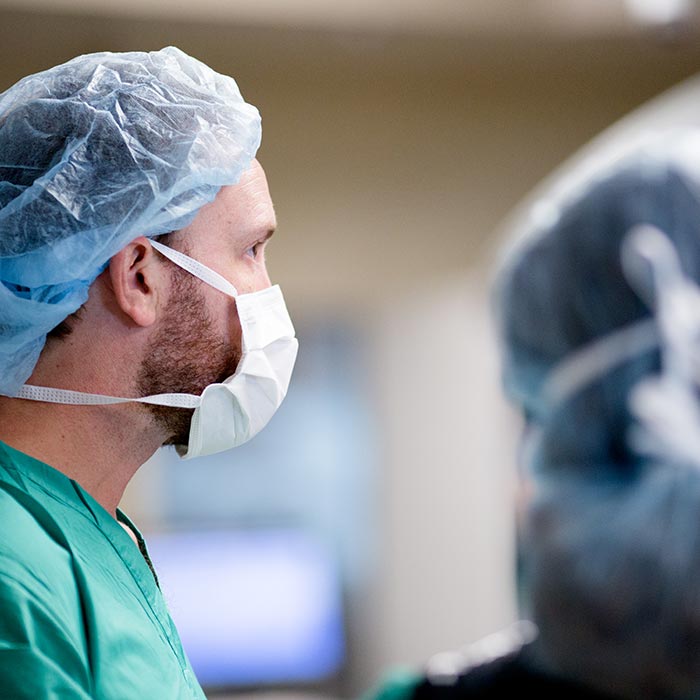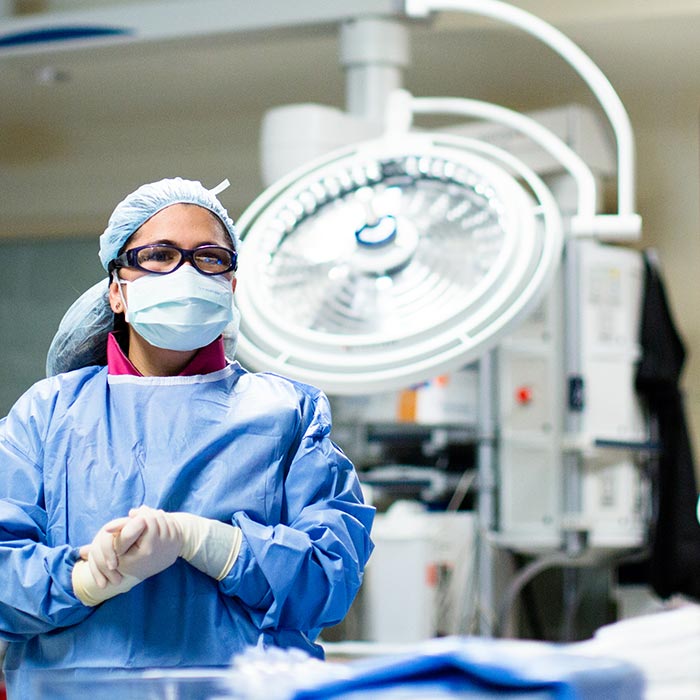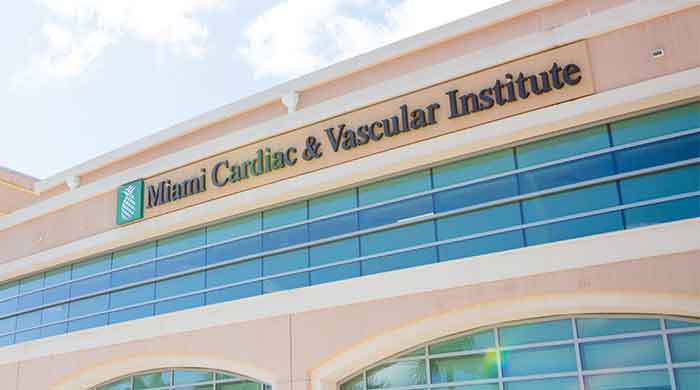
No bounds. Better healthcare.
Instituting collaborative care at Miami Cardiac & Vascular Institute
Collaborative care delivery to benefit physicians, staff and patients
Operational silos come in many forms. In a hospital for example, there are physical, clinical and information silos that can prevent the collaboration needed to make the care decisions that benefit patients. When Miami Cardiac & Vascular at Baptist Health South Florida was founded in 1987, it was founded on three pillars: a commitment to less invasive therapy; a strategic focus around multidisciplinary care; and creating an environment of transparency. Creating a culture of collaboration in healthcare isn’t something that usually happens overnight. At MCVI it is part of a 30-year design to break down barriers in order to provide integrated, patient-centric care through one cohesive, technology-enabled team. “In order to take care of a patient anywhere in any hospital in any environment, it takes a team,” says Carol Melvin, Chief Operating Officer of Miami Cardiac & Vascular Institute. “Nurses can’t work without physicians, physicians can’t work without nurses and staff. In order for us to provide that quality care to the patient, the team has to be a well-oiled, cohesive machine. No one can do this alone.”
Solving patient problems
Early in 2017 the Institute completed an expansion to their facilities on its Baptist Hospital campus, the design of which included additional space and equipment. It also facilitated the creation of several new, specialized programs, all focused on the Institute’s founding promise to bring together multidisciplinary healthcare teams of specialists to treat the cardiovascular care delivery system as a single entity. “At the physician practitioner level, that’s pretty challenging because many individual practitioners are really solo entrepreneurs that are, in fact, competitive with one another, and so we’ve been able to harness those competitive forces into collaborative forces, I think, that has benefited everybody,” says Barry T. Katzen, M.D., founder and Chief Medical Executive of Miami Cardiac & Vascular Institute. Open gallery views of interventional suites allow staff to understand that they’re working in an environment “where peer-to-peer relationships are important, and where peer-to-peer scrutiny is out in the open.” The environment is such where any type of image-guided procedure could be performed with multidisciplinary care teams working together to solve a patient’s problem. At a TAVR (trans-catheter aortic valve replacement) meeting, for example, physicians from multiple disciplines all congregate in the large ‘fishbowl’ conference room at the Institute to evaluate patient cases, including echocardiographers, interventional cardiologists, interventional radiologists, the vascular surgery team and the imaging team. “In traditional hospitals, the various [clinical] specialties are in silos, so the rooms may be lined up in one hallway in one department, and there may be other kinds of procedure rooms lined up in another hallway all the way across the hospital,” says Melvin. In addition to physical space and clinical specialty silos, data and IT systems are also frequently not integrated. “Years ago, we developed a unique floor plan to provide that kind of interaction, as we affectionately call ‘working in the sunshine,’ where we have a glassed area that allows us to not only see what’s going on in every room, but to have all the physicians participate in any type of care that’s needed in those rooms. That creates an environment of collaboration rather than an environment of silos.”
‘Working in the sunshine’
At a TAVR (trans-catheter aortic valve replacement) meeting, for example, physicians from multiple disciplines, including echocardiographers, interventional cardiologists, interventional radiologists, the vascular surgery team and the imaging team, all congregate in the large ‘fishbowl’ conference room at the Institute to evaluate patient cases. “In traditional hospitals, the various [clinical] specialties are in silos, so the rooms may be lined up in one hallway in one department, and there may be other kinds of procedure rooms lined up in another hallway all the way across the hospital,” says Ms. Melvin. In addition to physical space and clinical specialty silos, data and IT systems are also frequently not integrated. “Years ago, we developed a unique floor plan to provide that kind of interaction, as we affectionately call ‘working in the sunshine,’ where we have a glassed area that allows us to not only see what’s going on in every room, but to have all the physicians participate in any type of care that’s needed in those rooms. That creates an environment of collaboration rather than an environment of silos.”
Collaborating seamlessly
The philosophy behind the Institute’s re-design – that all clinical specialties should come together to work for the patient – drives the culture of multidisciplinary care and open collaboration at the Institute. “In our day-to-day practice you will have interventional cardiologists working next to interventional radiologists working along with cardiothoracic surgeons and the vascular surgeons and other types of interventionists, really for the best care for the patient,” says Constanino Peña, M.D., an interventional radiologist and Medical Director of Vascular Imaging at the Institute. The problem with patients with more than one chronic disease is that they are not necessarily siloed in one specialty: they may have multiple problems that require attention. The Institute’s philosophy is designed to address that problem; by working together in a multi-disciplinary environment, and not as individual specialists, they are able to provide the best care to the patient as a whole. “No single person or specialty can have all of the expertise required to care for some of these complex patients, and by collaborating seamlessly it really lets the patient reap the benefits of being in a place where you have a lot of specialties represented with a lot of experience,” says Marcus St. John, M.D., a cardiologist and Medical Director of the Cardiac Cath Lab at the Institute.
Breaking information silos
Equally important, the hospital says, is breaking down information silos across the organization and each clinical specialty to understand how data is being used to improve the patient experience, whether it is integrating patient data from multiple clinical sources (the cath lab, MRI or CT scans) or the ability to have high-quality imaging across all imaging modalities. The days of information silos – where data exists within each clinical specialty – are over at the Institute. Ultimately the benefit to patients and families is enhanced care delivery from all care providers and across settings – from diagnosis and treatment through to post-care – who now have access to the same information. “People shouldn’t live in silos as it relates to clinical care, and we shouldn’t live in silos when it comes to sharing data and sharing best practices,” says Ms. Melvin. “Nothing can be accomplished unless you do it as a team, and to build a strong, collaborative team requires re-thinking the way clinical specialties work together, for the benefit of the patient.”
Less invasive.
Shorter stays.
A customer story from Miami Cardiac & Vascular Institute
In order to take care of a patient anywhere, in any hospital, in any environment, it takes a team."
COO of Miami Cardiac & Vascular Institute
Carol Melvin



People shouldn't live in silos as it relates to clinical care, and we shouldn't live in silos when it comes to sharing data and sharing best practices."
COO of Miami Cardiac & Vascular Institute
Carol Melvin
Cardiovascular care with Philips Azurion Image Guided Therapy Platform
No bounds.
Better healthcare.
There's always a way to make life better.

DISCLAIMER: Results from case studies are not predictive of results in other cases. Results in other cases may vary.

